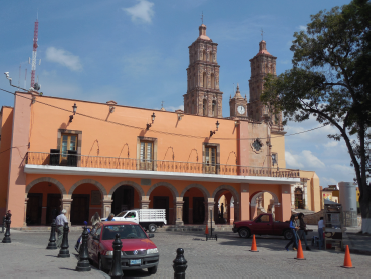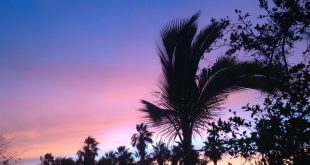Already steeped in Mexican colonial history after a stay in Guanajuato and San Miguel de Allende, we drove 27 km, away from city hustle and bustle to the iconic town of Dolores Hidalgo. At 6500 feet altitude, the air was pristine and crisp, and the sky an unnatural blue. Looking around as we parked in the “Jardin” or central heavily treed plaza lined with colorful arches, it was easy to understand why the town of Dolores has acquired pilgrimage status. Mexicans consider it the birthplace of independence.
The huge rose-colored cantera stone façade of the church first beckons the visitor. There on September 16, 1810, Father Miguel Hidalgo rang the bells of his church to summon folks and bellowed his impassioned and now emblematic “Grito” calling for rebellion against Spanish rule. His ragtag army of some 300 native people armed with farm implements set out and, having enlisted thousands in their wake, won a battle against the caudillo in Guanajuato 12 days later. This sparked the first revolution as several other towns were taken by Hidalgo’s forces, ending in his defeat and capture a year later.
The spirit of independence which infuses the whole town is best understood from a visit through the old jail, now the Bicentennial Museum which commemorates both the 1810 and 1910 revolutions. Cavernous halls housing exhibits and dioramas bring to life the struggles of the many Mexican people whose name never broke into print.
Everywhere around the plaza and in adjacent streets are small stores and carts that sell an astounding selection of ice cream to which the local population seems to be addicted. Passing up flavors such as shrimp and octopus, we made our way to El Carruaje, a restored 1920 courtyard home, now a two-story vintage restaurant.
An explosion of colors stuns you as you enter and take in huge period paintings and local blown glass artifacts. To the strains of Jose Alfredo Jimenez, a Dolores native son, composer of a thousand songs, and father of mariachi, we enjoyed local specialties served by amiable costumed waitresses.
On the way back to San Miguel, we resisted stopping at the talavera factories – talavera is native to Dolores and employs 80% of the population- and instead resorted to Taboada, one of the many hot springs establishments peppering the whole region.
Feeling relaxed and rejuvenated from a soak in 104 degree water naturally heated by some underlying magma, I could not help but think as much turbulence goes on below the earth’s crust as does above.
 Baja Review A community newspaper serving Ensenada, Valle de Guadalupe, and Rosarito in Northern Baja California
Baja Review A community newspaper serving Ensenada, Valle de Guadalupe, and Rosarito in Northern Baja California





